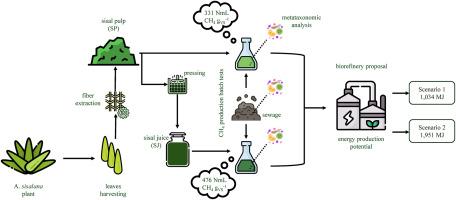Transforming Agave sisalana waste into high-yield biogas: An approach to sustainable energy
IF 5.8
2区 生物学
Q1 AGRICULTURAL ENGINEERING
引用次数: 0
Abstract
Agave, a native Mexican plant widely used for fiber extraction and alcoholic beverage production, has significant potential for biogas generation. Brazil, the global leader in sisal fiber production, extracts fiber from only 4 % of the agave leaf, leaving approximately 24 tons of organic residue per ton of fiber. These residues can be converted into methane (CH4) through anaerobic digestion (AD). This study explores biogas production from agave fiber extraction residues. The juice and pulp contain high levels of calcium, potassium, magnesium (2–3 gL-1), citric acid (56 g L−1), and formic acid (76 g L−1). Methane potentials were 476 NmLCH4 gVS−1 for the juice and 331.10 NmLCH4 gVS−1 for the pulp. Anaerobic digestion revealed microbial groups such as Anaerolineae, Synergistia, Clostridia, Bacteroidia, and Gammaproteobacteria, which degrade carbohydrates and volatile fatty acids. Halobacteriota, a methane-producing archaea, predominated in all samples. Energy recovery scenarios considering raw sisal pulp direct AD (1) and an integrated biorefinery proposal (2) suggests that 1034 MJ of energy can be obtained per ton of biomass, reaching 1951 MJ when integrated into a biorefinery. This study emphasizes the value of agave defibration residues, typically discarded, and proposes an AD-based biorefinery model to enhance the sustainability of sisal fiber production.

将龙舌兰废弃物转化为高产沼气:一种可持续能源的方法
龙舌兰是一种墨西哥本土植物,广泛用于纤维提取和酒精饮料生产,具有巨大的沼气潜力。巴西是剑麻纤维生产的全球领导者,仅从龙舌兰叶中提取4%的纤维,每吨纤维留下约24吨有机残留物。这些残留物可以通过厌氧消化(AD)转化为甲烷(CH4)。本研究探讨了龙舌兰纤维提取渣生产沼气的方法。果汁和果肉含有高水平的钙、钾、镁(2-3 gL-1)、柠檬酸(56 gL-1)和甲酸(76 gL-1)。果汁的甲烷势为476 NmLCH4 gVS−1,果肉的甲烷势为331.10 NmLCH4 gVS−1。厌氧消化发现了一些微生物群,如厌氧菌、增效菌、梭菌、拟杆菌和γ变形菌,它们能降解碳水化合物和挥发性脂肪酸。盐杆菌是一种产生甲烷的古生菌,在所有样品中占主导地位。考虑剑麻原浆直接AD(1)和一体化生物炼制方案(2)的能量回收方案表明,每吨生物质可获得1034兆焦耳的能量,一体化生物炼制后可获得1951兆焦耳的能量。本研究强调了龙舌兰脱纤残渣(通常是废弃的)的价值,并提出了一种基于ad的生物精炼模型,以提高剑麻纤维生产的可持续性。
本文章由计算机程序翻译,如有差异,请以英文原文为准。
求助全文
约1分钟内获得全文
求助全文
来源期刊

Biomass & Bioenergy
工程技术-能源与燃料
CiteScore
11.50
自引率
3.30%
发文量
258
审稿时长
60 days
期刊介绍:
Biomass & Bioenergy is an international journal publishing original research papers and short communications, review articles and case studies on biological resources, chemical and biological processes, and biomass products for new renewable sources of energy and materials.
The scope of the journal extends to the environmental, management and economic aspects of biomass and bioenergy.
Key areas covered by the journal:
• Biomass: sources, energy crop production processes, genetic improvements, composition. Please note that research on these biomass subjects must be linked directly to bioenergy generation.
• Biological Residues: residues/rests from agricultural production, forestry and plantations (palm, sugar etc), processing industries, and municipal sources (MSW). Papers on the use of biomass residues through innovative processes/technological novelty and/or consideration of feedstock/system sustainability (or unsustainability) are welcomed. However waste treatment processes and pollution control or mitigation which are only tangentially related to bioenergy are not in the scope of the journal, as they are more suited to publications in the environmental arena. Papers that describe conventional waste streams (ie well described in existing literature) that do not empirically address ''new'' added value from the process are not suitable for submission to the journal.
• Bioenergy Processes: fermentations, thermochemical conversions, liquid and gaseous fuels, and petrochemical substitutes
• Bioenergy Utilization: direct combustion, gasification, electricity production, chemical processes, and by-product remediation
• Biomass and the Environment: carbon cycle, the net energy efficiency of bioenergy systems, assessment of sustainability, and biodiversity issues.
 求助内容:
求助内容: 应助结果提醒方式:
应助结果提醒方式:


